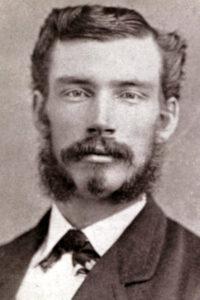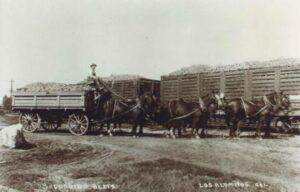CLAUDINE BURNETT BOOKS
Rancho Los Alamitos: − Part 3: The Bixby’s take over
By Claudine Burnett
Published: August 22nd, 2024
In Part 1 of this series, I traced the history of the Rancho Los Alamitos, carved from the vast Rancho Los Nietos in 1804, to Jose Figueroa, to American Abel Stearns. Part 2 dealt with landlord Michael Reese. Here’s more.
Following Rancho Los Alamitos’ owner Michael Reese’s death in 1878, W. S. Lyon, who had leased the ranch from Reese in 1871, rented several thousand acres of the Alamitos Rancho to John W. Bixby (1848-1887). John was a cousin to both the Flint and Bixby families who owned extensive acreage in Southern California.
John came to California at age 21 and was hired by his cousin, Jotham Bixby, at the Rancho Los Cerritos. There the former teacher met Jotham’s sister-in-law Susanna Patterson Hathaway (1845-1906). The two married on Oct. 4, 1873, and settled in Wilmington where their son, Fred Hathaway Bixby, was born (1875-1952). They lived in Wilmington for several years, until they had the chance to lease land on the Rancho Los Alamitos, where daughter Susanna Patterson Bixby Bryant (1880-1946) was born.

At the termination of Lyon’s ten-year lease in 1881 the whole Rancho Alamitos property came on the market at a tempting price. The young couple, who had been calling the Rancho home for several years, saw an opportunity that they could not pass up. But they didn’t have enough capital. They first approached Los Angeles banker, Isaias Wolf Hellman (1842-1920) who said he’d become a partner in the deal if Jotham Bixby would; Jotham said he would if Flint-Bixby & Company (comprised of Jotham and his brother Lewellyn along with cousin Thomas Flint), decided to become involved. In order to secure funds for his share of the purchase, Jotham Bixby considered William Willmore’s offer to purchase Rancho Los Cerritos land for what Willmore was calling the American Colony. The American Colony would eventually become Long Beach.
With funds secured, the three partners agreed and the 26,950-acre Rancho Alamitos was purchased for $125,000 ($3.84 million in 2023) with Hellman owning one-third, Flint-Bixby & Company another third, and young John Bixby as manager, the final third.
The new company obtained an initial $80,000 ($2.46 million) mortgage and began business under the name of J. W. Bixby & Company on July 11, 1881. The Los Angeles Herald (7/10/1881) reported the purpose of the newly organized company would be raising and trading in cattle, sheep, horses and other stock, including wool raising, dairy business, and pasturing animals.
−−−−
What was taking place on the rancho? The July 1, 1883, Los Angeles Times described the Rancho Los Alamitos as “probably the best natural stock farm in Southern California.” Originally, the entire southern portion of Los Angeles County was a swamp of little value. Bixby drained the water, transforming the southern section of the rancho, making it the most valuable portion of the estate.
Corn was the major commodity. In July 1883, there were five hundred acres planted in corn, put in by renters who paid proprietor John W. Bixby a share of the crop for the use of the land. There were also 150 acres of alfalfa which thrived on the moist, slightly alkali soil on the western portion of the rancho. The Times reported Bixby planned to gradually increase the alfalfa acreage until he had 1000 acres of alfalfa for sheep and cattle to feed on.
There were 1000 head of Durham cattle and 8000 head of Merino sheep on the ranch in 1883, as well as 300 milk cows, 140 being milked to supply the Alamitos cheese factory. The products of the factory gained such a reputation that it was impossible to keep up with demand. It was the only factory in the southern part of the State which made cheese in popular three pound and eight-pound weights. This, together with the fact that the cheese had a peculiarly rich flavor, created such a demand that the 230 pounds of cheese produced each day could not satisfy the need.
John Bixby was also experimenting with growing 15 acres of German millet. This was a famous Kansas crop which sold for 4 1/2 cents a pound. The stalk was sweet, highly nutritious, the grain was fattening and liked by stock. It had to be sowed annually like barley, and Bixby predicted that it would supersede barley once its merits became known. But sugar beets would prove the most profitable crop in future years after Lewellyn Bixby negotiated the building of one of the state’s first sugar beet factories on Rancho Los Alamitos land in 1896.

The consortium had bought at the right time. With the completion of the second transcontinental railroad in 1885, a price war developed between the new Santa Fe and the older Southern Pacific, bringing the cost of a ticket to California down to almost nothing. It was time to start selling land.
Next: Part 4 – From Crops to Cottages and the establishment of Alamitos Beach Townsite.
Categorized under:
Tagged as: